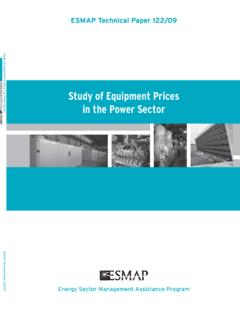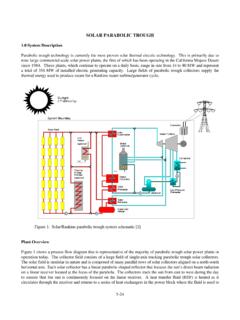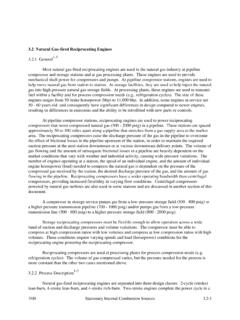Transcription of Estimates of Emissions from Coal Fired Thermal Power ...
1 Estimates of Emissions from Coal Fired Thermal Power plants in India Moti L. Mittal Department of Environmental and Occupational Health, University of South Florida, Tampa, Florida, USA. Chhemendra Sharma and Richa Singh Radio and Atmospheric Sciences Division, National Physical Laboratory, Council of Scientific and Industrial Research, Dr Krishnan Road, New Delhi 110012, India ABSTRACT. Coal is the primary fuel for electricity generation in India and its usage is continuously increasing to meet the energy demands of the country. This paper presents Emissions of carbon dioxide (CO 2 ), sulfur dioxide (SO 2 ), and nitric oxide (NO) from Thermal Power plants in India for a period of nine years from 2001-02 to 2009-10. The emission Estimates are based on a model in which the mass emission factors are theoretically calculated using the basic principles of combustion and operating conditions. Future emission scenarios for the period up to 2020-21 are generated based on the Estimates of the nine years from 2001-02 to 2009-10.
2 Power plants in India use different qualities of coal, different combustion technologies and operating conditions. As a result, these plants have differences in achieved efficiencies (coal usage per unit of electricity). The Estimates show region wise differences in total Emissions as well as differences in Emissions per unit of electricity. Computed Estimates show the total CO 2 Emissions from Thermal Power plants have increased from Gg for the year 2001-02 to Gg in 2009-10. SO 2 Emissions increased from Gg in 2001-02 to Gg in 2009-10, while NO Emissions increased from Gg to Gg during this period. The Emissions per unit of electricity are estimated to be in the range of to kg/kWh for CO 2 , to g/kWh for SO 2, and to g/kWh for NO during the period 2001-02 to 2009-10. The future emission scenario, based on the projected coal consumption in Indian Thermal Power plants by Planning Commission of India under Business-as Usual (BAU)' and Best case Scenario (BCS)' show the emission in the range of 714976 to 914680 Gg CO 2 , 4734 to 6051 Gg SO 2 and 366 to 469 Gg NO in the year 2020-21.
3 Increase in coal use efficiencies in electricity generation by Thermal Power plants can significantly reduce the Emissions of greenhouse and polluting gases. This methodology provides a useful tool for inventory preparation in a sector where measured values for Emissions factors are very sparse. INTRODUCTION. Emissions of greenhouse gases and other pollutants are increasing in India with the increasing demand for electricity. The aspiration for rapid economic growth leading to rapid industrialization coupled with accelerated urbanization and mechanization of agriculture has been responsible for this increasing demand of electricity ever since the independence. The electricity consumption grew from (billion kWh) in 2000 to (billion kWh) in 2008 at an annual growth rate of , while the electric Power generation grew from billion kWh in 2000 to billion kWh at an annual growth rate of 1( , 2010). Fig. 1 shows the growth of electricity generation and usage in India and China during the period 2000 to 2008 based on the EIA1 ( , 2010).
4 1. data. Large difference between electric Power generation and consumption are due to transmission and distribution losses. In India, the losses are extremely high and vary between 30 to 45%. To ensure Power on Demand', India has envisioned an additional generating capacity of 100,000 MW by the year 2012. It is estimated that electricity demand outstrips supply by 7-11%. With India's population of more than a billion that is growing at an annual rate of about 2%2 (World Bank, 2000), the gap between demand and supply of the electricity may rise further. India 's current3. ( Annual Report 2008-09) electric Power availability is approximately %. short of demand with peak load shortages of %, whereas in 2000-01, Power capacity was %. short of demand with peak load shortage of 13%. Percentage of the electric energy shortage and peak shortage from the period 2000-01 to 2008-09 are shown in Fig. 2. Coal is the favorite fuel for the electricity generation in countries like India and China.
5 Abundant supply of coal locally and sustained high prices for imported natural gas and oil make coal- Fired generation of electricity more attractive economically. Coal is approximately 90% of the total fuel mix for electricity generation. Fig. 3 shows the percentage of generating capacity of all categories that includes natural gas, diesel, nuclear, hydro, and renewal energy sources like biomass Power , urban &. industrial waste Power , and wind energy. Coal and lignite based Power plants have approximately of the total electric Power generation capacity in India. However, relatively lower calorific value, coupled with high ash content and inefficient combustion technologies aggravates emission of greenhouse gases and other pollutants from India's coal and lignite based Thermal Power plants . Main Emissions from coal Fired and lignite based Thermal Power plants are CO 2 , NO x , SO x , and air-borne inorganic particles such as fly ash, carbonaceous material (soot), suspended particulate matter (SPM), and other trace gas species.
6 Thermal Power plants , using about 70% of total coal in India4 (Garg et. al., 2002), are among the Large Point Sources (LPS) having significant contribution (47% each for CO 2 and SO 2 ) in the total LPS Emissions in India. Only limited efforts5 (Chakraborty et al., 2008) have been made so far for measuring the plant specific Emissions of different gases and particulate matter in India to generate plant specific emission factors. These measurements were taken at few small plants of less than 250 MW capacities. For preparing the national green house gas (GHG) emission inventories from electricity generation in Indian Thermal Power plants , default emission factors prescribed by the Intergovernmental Panel on Climate Change (IPCC)6 [IPCC, 1996] have so far been used along with the country specific net calorific values (NCV) of Indian coal types7 (INCCA, 2010). Earlier electric Power generation from Thermal Power plants was estimated to have contributed about 96% of total carbon dioxide (CO 2 ) Emissions during 19908 (ALGAS ,1998) while in 1994, it was estimated about 62% 9(NATCOM, 2004) and in 2007, it has been estimated about 69% of the total CO 2 -equivalent Emissions from energy sector7 (INCCA, 2010).
7 The differences between 1990 Estimates and 1994 and 2007 Estimates also capture the different methodological approaches followed in these sets of Estimates . The IPCC default emission factors, used in Indian inventory estimation, represents the average of available emission values using the similar fuel and technical processes under similar national circumstances and do not account for Indian coal characteristics or the operating conditions at the various Thermal Power plants in India. A time series of emission trends of CO 2 , NO x , and SO x from the Indian coal Fired and lignite based Thermal Power plants over a decade (2001-02 to 2009-10) is presented here. Eighty six Power plants with total installed capacity of 77682 MW are considered in this analysis for which required input 2. data was available from Central Electricity Authority of India10 (CEA). These plants represent about 76% of the total installed capacity of Thermal Power plants in India.
8 As of March 2010, there are 105. Thermal Power plants in India of more than 100 MW capacity each, with total installed generation capacity of 93772 MW. As per the CEA ( , 2011), public sector Thermal Power plants have total installed capacity of about 87592 MW while the private sector has a total installed capacity of about 14962 MW which include captive Thermal Power plants of less than 100 MW installed capacity. The combustion technology in these 86 plants is based on pulverized coal burning but the type of furnace technology, design of the boiler, forced draught fans etc. differ with plants . Based on the CEA. data ( 2010), specific coal usage at three plants is less than kg/kWh, at 19 plants , usage is between kg/kWh, thirty nine plants use coal between kg/kWh, fifteen plants use between kg/kWh, seven plants use between kg/kWh, and at three plants coal usage exceeds kg/kWh. Hence the efficiency of the plants and the coal usage per unit of electricity generation also differ at each plant.
9 There is a need to modernize India's Thermal Power plants and reduce the coal usage per unit of electricity generation (kg/kWh). Modernization with reduction in coal usage (kg/kWh) will help in reducing the national Emissions . Quality of Indian coal will remain same but with the improvement in combustion technologies, Emissions can be reduced. It is estimated that 1% to 2% increase in heat rate improvements leading to efficiency improvement will result in 1% to 2% decrease in Emissions per unit of electricity11 (USAID/TVA/NTPC 2000). Here, the emission factors for each of the 86 plants are computed based on the basic principles of coal combustion, characteristics of the coal used in different Thermal Power plants , and the operating conditions in these plants . This methodology provides a `bottom-up' approach for the development of emission inventory. This is the first study where emission inventory of CO 2 , SO 2 , and NO are developed specifically for coal Fired Thermal Power plants in India based on the characteristic of coal and operating conditions prevalent at the plant.
10 METHODOLOGY. The combustion process of the pulverized coal in the boiler is a complicated non-linear phenomenon. The pollutants emitted from Thermal Power plants depend largely upon the characteristics of the fuel burned, temperature of the furnace, actual air used, and any additional devices to control the Emissions . At present, the control devices used in Thermal Power plants in India is electrostatic precipitator (ESP) to control the emission of fly ash (SPM). Some new plants use low NO x burners for high temperature (> 1500 K) combustion technologies and dry/wet SO 2 scrubber, if chimney height is less than 275 meters. Mass emission factors for CO 2 , SO 2 , and nitric oxide (NO) are computed based on the input data, such as chemical composition of the coal used at the Power plants and the actual air used during combustion. These calculations are based on theoretical ideals and do not take account for the control devices. Indian coal generally has low sulfur contents.












